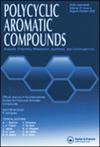Synthesis, X-Ray, Spectral Characterization, DFT, and Molecular Docking Calculations of 2-(5-Nitro-1-H-Indazol-1-yl) Acetic Acid
IF 2.4
3区 化学
Q2 CHEMISTRY, ORGANIC
引用次数: 0
Abstract
In this work, theoretical and experimental studies of a new Indazole derivative named 2-(5-nitro-1-H-indazol-1-yl) acetic acid (3), including the synthesis and characterization by 1H and 13C-NMR, FT-IR, UV spectroscopies are reported together with its X-ray crystal structure. The compound crystallizes in the monoclinic crystal system of P21/c space group and unit cell constants: a = 7.8541(10) Å, b = 7.9274(11) Å, c = 15.877(2) Å, β = 101.149(5)°. In the crystal, O–H···N and C–H···O hydrogen bonds form a 3-D network structure containing small channels running parallel to the b-axis. B3LYP/6-311++G** calculations in the gas phase and ethanol solution suggest the existence of C1 and C2 conformers where the structure of C1 in both media is in agreement with that observed by X-ray diffraction. Probably, the high values observed in the dipole moments of C1 justify its presence in gas and solution phases. The stabilities of both forms were justified by NBO and AIM calculations where C1 is more stable than C2. C1 shows a higher solvation energy, dipole moment, and higher hydration than C2 while the frontier orbitals suggest a higher reactivity of C1 over C2. Force fields and complete vibrational assignments were performed for the C1 conformer because it was detected in the solid phase. Scaled force constants for both forms are also reported. Calculated chemical shifts for (3) are consistent with the experimental 1H and 13C-NMR spectra in the DMSO-d6 solution. The anti-COVID activity of 3 is investigated by its molecular docking into the binding site of SARS CoV-2 3CLpro (3 C-like protease). It shows a moderate binding affinity into the binding site of 3 C-like protease with a maximum binding energy of −5.57 kcal mol−1.
2-(5-硝基-1-H-吲唑-1-基)乙酸的合成、X 射线、光谱表征、DFT 和分子 Docking 计算
本研究报告对一种名为 2-(5-硝基-1-H-吲唑-1-基) 乙酸 (3) 的新吲唑衍生物进行了理论和实验研究,包括合成、1H 和 13C-NMR 表征、傅立叶变换红外光谱、紫外光谱以及 X 射线晶体结构。该化合物在 P21/c 空间群的单斜晶系中结晶,单胞常数为:a = 7.8541(10) Å, b = 7.9274(11) Å, c = 15.877(2) Å, β = 101.149(5)° 。在晶体中,O-H--N 和 C-H-O 氢键形成了一个包含平行于 b 轴的小通道的三维网络结构。气相和乙醇溶液中的 B3LYP/6-311++G** 计算表明存在 C1 和 C2 构象,其中 C1 在这两种介质中的结构与 X 射线衍射观察到的结构一致。在气相和溶液中观察到的 C1 偶极矩的高值可能证明了其存在的合理性。NBO 和 AIM 计算证明了这两种形态的稳定性,其中 C1 比 C2 更稳定。C1 显示出比 C2 更高的溶解能、偶极矩和更高的水合作用,而前沿轨道则表明 C1 比 C2 具有更高的反应活性。由于在固相中检测到了 C1 构象,因此对其进行了力场和完整的振动赋值。同时还报告了两种构象的比例力常量。(3) 的计算化学位移与 DMSO-d6 溶液中的实验 1H 和 13C-NMR 光谱一致。通过与 SARS CoV-2 3CLpro(3 C 样蛋白酶)结合位点的分子对接,研究了 3 的抗 COVID 活性。它与 3 C 样蛋白酶结合位点的结合亲和力适中,最大结合能为 -5.57 kcal mol-1。
本文章由计算机程序翻译,如有差异,请以英文原文为准。
求助全文
约1分钟内获得全文
求助全文
来源期刊

Polycyclic Aromatic Compounds
化学-有机化学
CiteScore
3.70
自引率
20.80%
发文量
412
审稿时长
3 months
期刊介绍:
The purpose of Polycyclic Aromatic Compounds is to provide an international and interdisciplinary forum for all aspects of research related to polycyclic aromatic compounds (PAC). Topics range from fundamental research in chemistry (including synthetic and theoretical chemistry) and physics (including astrophysics), as well as thermodynamics, spectroscopy, analytical methods, and biology to applied studies in environmental science, biochemistry, toxicology, and industry. Polycyclic Aromatic Compounds has an outstanding Editorial Board and offers a rapid and efficient peer review process, as well as a flexible open access policy.
 求助内容:
求助内容: 应助结果提醒方式:
应助结果提醒方式:


